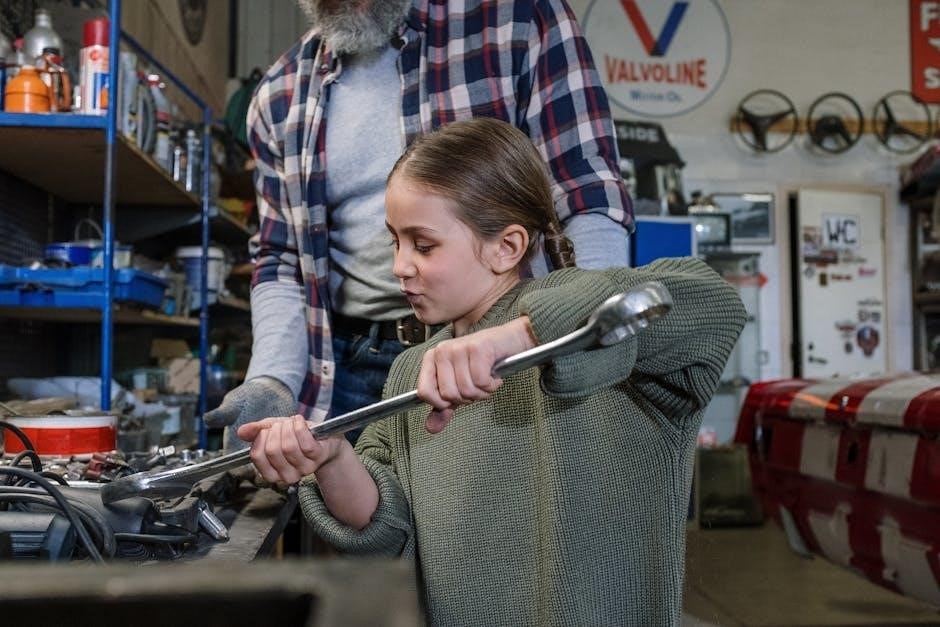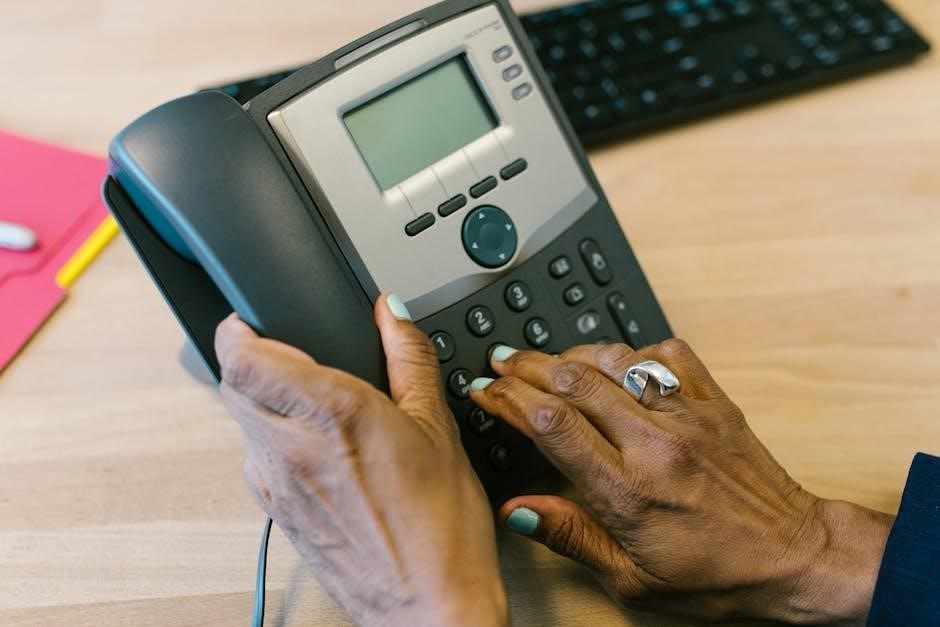
Clicker Garage Door Keypad Manual: A Comprehensive Guide
Welcome! This comprehensive guide provides essential information for your Clicker garage door keypad․ We will cover everything from identifying your opener type to troubleshooting common issues․ Follow along for seamless programming and operation so you can get started․
Understanding the Clicker Garage Door Keypad
The Clicker garage door keypad offers a convenient and secure way to access your garage without needing a traditional key or remote․ This wireless device uses a personal identification number (PIN) for entry, enhancing your home’s security․ The backlit keypad ensures visibility in all lighting conditions, which allows for easy use day or night․
Setting up your Clicker keypad involves programming it to communicate with your garage door opener․ This process typically requires identifying your garage door opener’s type and following specific programming steps․ Whether you have a green learn button or an external receiver, understanding the nuances of your opener is crucial for successful setup․
This guide provides clear, step-by-step instructions to help you program and maintain your Clicker keypad․ We will cover initial PIN setup, memory clearing, and troubleshooting common issues․ With proper understanding and maintenance, your Clicker keypad will provide reliable and secure access to your garage․
Identifying Your Garage Door Opener Type
Before programming your Clicker garage door keypad, correctly identifying your garage door opener type is essential․ This identification determines the programming steps you will need to follow․ Most garage door openers have a “Learn” button, which is crucial for syncing the keypad․ The color and location of this button vary by manufacturer and model․
Common types include openers with a green, yellow, red, orange, or purple “Learn” button․ Some older models might use dip switches instead of a “Learn” button․ If you have an external receiver, the programming process will differ․ Check your garage door opener’s manual for specific details about your model․
To identify your opener type, first locate the motor unit in your garage․ Look for the “Learn” button and note its color․ If you cannot find a “Learn” button, consult your opener’s manual or search online using the model number․ Correct identification ensures a smooth and successful programming experience for your Clicker keypad․
Programming the Initial PIN
Programming your Clicker garage door keypad begins with setting up an initial Personal Identification Number (PIN)․ This PIN will be used to open and close your garage door․ Ensure the keypad is within range of your garage door opener during this process․

Start by pressing the “Program” button on the keypad until the LED light turns on․ Next, enter your desired 4-digit PIN․ Make sure to choose a memorable but secure code to prevent unauthorized access․ After entering your PIN, press the “Program” button again․
The LED light should start flashing, indicating that the keypad is ready to sync with the garage door opener․ Now, locate the “Learn” button on your garage door opener motor․ Press and release the “Learn” button․ Within 30 seconds, return to the keypad and enter your PIN again, then press the “Program” button one last time․ The garage door should now activate, confirming successful programming․ If the door doesn’t activate, repeat these steps or consult the troubleshooting section․
Clearing the Memory: Resetting the Keypad
Resetting your Clicker garage door keypad is useful when you need to erase previous settings, especially if you’re experiencing programming issues, or if you’re moving into a new home; This process clears all stored PINs and configurations, allowing you to start fresh with the programming process․
To begin, locate the “Program” button on your Clicker keypad․ Press and hold this button until the LED light begins to flash rapidly․ This usually takes around 5-10 seconds․ Once the LED is flashing quickly, release the “Program” button․
Next, immediately press and release the “0” button on the keypad․ This action confirms that you want to clear the memory․ After pressing “0,” wait for the LED light to turn off, indicating that the reset is complete․ Now, your Clicker keypad is reset to its factory default settings, and you can proceed with programming a new PIN․ Remember to refer to the programming instructions to set up your desired PIN and sync the keypad with your garage door opener․
Step-by-Step Programming Instructions
Programming your Clicker garage door keypad involves a series of straightforward steps․ First, ensure that your garage door opener is compatible with the Clicker keypad․ Refer to your garage door opener’s manual to confirm compatibility․ If compatible, locate the “Learn” button on your garage door opener motor․ This button is typically located on the back or side of the motor unit․
Next, enter your desired 4-digit PIN on the Clicker keypad․ After entering the PIN, press and release the “Program” button on the keypad․ The LED light on the keypad should start flashing․ Immediately after pressing the “Program” button, press the “Learn” button on your garage door opener motor․ The garage door opener light should flash, indicating that it has received the signal from the keypad․
Finally, test the keypad by entering your programmed PIN and pressing the “Enter” button․ The garage door should now open or close․ If it doesn’t, repeat the programming steps, ensuring each step is followed precisely․ If issues persist, consult the troubleshooting section of this guide․
Using the Learn Button
The “Learn” button on your garage door opener is crucial for programming your Clicker keypad․ This button allows the keypad to communicate with the opener, enabling wireless operation․ Locating the “Learn” button is the first step․ It’s usually found on the back panel of the garage door opener motor unit, often near the antenna wire․ The color of the “Learn” button can vary (green, yellow, red, or purple), indicating the opener’s security type․
Once located, pressing the “Learn” button initiates a short window (typically 30 seconds) during which the opener is receptive to new programming signals․ To program the keypad, press and release the “Learn” button․ Immediately afterward, enter your desired PIN on the keypad, followed by pressing the “Program” or “Enter” button․ The garage door opener light should flash, confirming successful programming․ If the light doesn’t flash, repeat the process․
For openers with rolling code technology, pressing the “Learn” button synchronizes the keypad with the opener’s changing security codes, enhancing security and preventing unauthorized access․ Always ensure the keypad is within range of the opener for successful programming․
Programming with a Green Learn Button
If your garage door opener has a green “Learn” button, it indicates a specific type of security system․ Programming a Clicker keypad with a green “Learn” button involves a straightforward process․ First, locate the green “Learn” button on the garage door opener motor unit․ Press and release this button․ A small LED light near the button will illuminate, indicating that the opener is ready to learn a new code․
Within 30 seconds of pressing the “Learn” button, go to your Clicker keypad․ Enter your desired four-digit PIN․ After entering the PIN, press the “Program” or “Enter” button on the keypad․ The garage door opener light should flash, confirming that the keypad has been successfully programmed․ If the light does not flash, repeat the process, ensuring you are within range and enter the PIN correctly․
For added security, some models may require you to press the “Learn” button a second time after entering the PIN on the keypad․ Always refer to your Clicker keypad manual for specific instructions, as slight variations may exist depending on the model․ Regular testing of the keypad after programming is recommended to ensure it operates correctly․
Programming with an External Receiver
Some older garage door openers, or those used in commercial settings, might utilize an external receiver․ Programming a Clicker keypad to work with an external receiver requires a slightly different approach․ First, locate the external receiver unit․ It is typically a small box mounted near the garage door opener motor, not integrated into the motor itself․ The receiver should have a “Learn” button or a similar programming button․
Press and release the “Learn” button on the external receiver․ An indicator light on the receiver should illuminate, signaling it is ready to learn a new code․ Within the specified time frame (usually 30 seconds), enter your desired four-digit PIN on the Clicker keypad․ After entering the PIN, press the “Program” or “Enter” button on the keypad․

The indicator light on the external receiver should either flash or turn off, confirming that the code has been successfully programmed․ If the light does not respond, repeat the process, making sure you are within range and entering the PIN correctly․ In some cases, the external receiver may require you to hold down the “Learn” button while entering the PIN on the keypad․ Always consult the documentation for both the Clicker keypad and the external receiver for precise instructions and compatibility information․ Regular testing is crucial․
Troubleshooting Common Issues
Even with careful programming, issues can arise with your Clicker garage door keypad․ One of the most common problems is a keypad that simply refuses to respond․ Before assuming a major malfunction, try replacing the batteries․ Low batteries are often the culprit behind a non-responsive keypad․ Ensure you are using fresh, high-quality batteries and install them correctly, following the polarity markings inside the battery compartment․
Another frequent issue is the keypad accepting the PIN but the garage door not opening․ In this case, double-check that the keypad is properly programmed to your garage door opener․ You may need to repeat the programming steps, ensuring you are using the correct method for your opener type (e․g․, using the “Learn” button)․ Also, make sure there are no obstructions blocking the signal between the keypad and the garage door opener․
If you’ve recently changed your garage door opener’s batteries, it may have reset its memory, requiring you to reprogram the keypad․ Interference from other wireless devices can also disrupt the signal․ Try moving other devices away from the keypad and opener to see if that resolves the issue․ Regularly inspect your keypad․
Keypad Not Working
If your Clicker keypad isn’t working, start by checking the batteries․ Low batteries are a primary cause of keypad failure․ Replace them with fresh, high-quality batteries, ensuring they’re correctly installed according to the polarity markings․ If the keypad still doesn’t respond, try cleaning the keypad buttons with a soft, dry cloth․ Dirt and debris can sometimes interfere with the button contacts․
Another common issue is incorrect PIN entry․ Double-check that you’re entering the correct PIN․ If you’ve forgotten your PIN, you may need to reset the keypad to its factory settings, which requires following the specific reset instructions for your model (usually involving pressing and holding certain buttons)․ After resetting, reprogram the keypad with a new PIN․ Wireless interference can also prevent the keypad from communicating with the garage door opener․ Try repositioning the keypad or the opener to minimize interference from other devices․

If none of these steps work, the keypad itself may be faulty․ Contact a professional garage door technician․
Changing the PIN
Changing your Clicker garage door keypad PIN is essential for maintaining security․ To begin, locate the “Program” or “Learn” button on your garage door opener motor unit․ This button might be under the light cover or on the back panel․ Press and release this button; a small LED light should illuminate, indicating that the opener is in programming mode․
Next, enter your existing PIN on the Clicker keypad, followed by the “#” key․ The keypad should beep or flash to confirm․ Then, enter your new desired four-digit PIN and press the “#” key again․ The keypad should beep or flash again to confirm the new PIN․ Finally, press the “0” key to activate the garage door opener and complete the programming process․
Test the new PIN by entering it on the keypad and pressing the “#” key․ The garage door should open or close, confirming that the PIN change was successful․ If the door doesn’t respond, repeat the steps carefully, ensuring each step is followed precisely․
Wireless Programming Setup
Setting up your Clicker garage door keypad wirelessly involves a few straightforward steps․ First, ensure your keypad has fresh batteries to guarantee a smooth programming process; Locate the “Learn” button on your garage door opener’s motor unit; this is typically found on the back or side panel and is often brightly colored (e․g․, yellow, green, or orange)․

Press and release the “Learn” button․ You’ll usually have about 30 seconds to complete the next step․ Immediately go to your Clicker keypad and enter your desired four-digit PIN, followed by pressing the “Enter” or “#” key․ The garage door opener should now recognize the keypad․ If the garage door doesn’t activate, repeat the process, ensuring you press the “Learn” button and enter the PIN within the given timeframe․
Some openers might require you to press the “Learn” button twice․ After entering your PIN, press the “Enter” or “#” key again to finalize the programming․ Test the keypad by entering your PIN and pressing the “Enter” or “#” key․ The garage door should open or close, confirming successful wireless programming․
Maintaining Your Clicker Keypad
Proper maintenance ensures your Clicker keypad operates reliably for years; Regularly check the batteries, replacing them annually or when the keypad’s backlight dims․ A weak battery can cause intermittent issues or complete failure․ Clean the keypad surface with a soft, damp cloth to remove dirt and grime․ Avoid using harsh chemicals or abrasive cleaners, as they can damage the keypad buttons and housing․
Periodically test the keypad’s range by operating it from various distances․ If the range diminishes, consider replacing the batteries or repositioning the keypad for better signal transmission․ In colder climates, protect the keypad from extreme temperatures, as they can affect battery performance․
Inspect the keypad housing for cracks or damage, which can allow moisture to enter and corrode internal components․ If damage is evident, replace the keypad promptly․ To prevent unauthorized access, change your PIN regularly, especially if you suspect it has been compromised․ By following these simple steps, you’ll extend the life of your Clicker keypad and maintain its optimal performance․